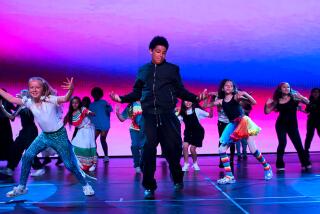Cambodia in legends, lore and a monkey king
- Share via
Cambodian dance is a revelation and occasionally a mystery. It easily transports the audience to an idealized, otherworldly realm. Yet, for a Westerner, sometimes there’s a feeling that crucial meanings are being missed.
That was the impression of the lovely “Harmony/Disharmony” program danced by Sophiline Cheam Shapiro and her Long Beach-based Khmer Arts Academy on Friday as part of this summer’s Grand Performances series at California Plaza in downtown L.A.
Shapiro is part of that heroic generation of “killing fields” survivors who have struggled to revive the classical dance culture the Khmer Rouge sought to obliterate -- among other parts of Cambodian life -- in its sweeping, savage attempt to remake the human being.
Her 20-member company ranges from 9-year-olds to adults, naturally at varying states of mastering a technique that demands reshaping the body, much as ballet does. Fingers and elbows are stretched to flex backward. Hand gestures flow slowly and fluidly into asymmetrical designs. The body dips gently or rises into weightless images of flight.
The dancers are dressed in shimmering costumes of golds, blues and blacks, into which they often must be sewn. They wear golden headdresses and look serenely into the distance. They are not like us nor are they supposed to be. They bring into our mundane existence a breath of spirit.
The eight-part program included two episodes about the monkey king Hanuman, a love duet, a myth about the creation of Kampuchea (Cambodia) and a work that uses traditional dance vocabulary to tell a contemporary story.
“Monosanchetana” (Sentiment Dance) shows a prince and princess meeting and tenderly falling in love. For some reason, they have to part. This is one of those moments of mystery. Perhaps a well-known back story explains why.
This duet was fluently danced by Shapiro and Chan Charya Burt, one of the three guest artists on the program. It may have surprised some people in the audience that two women played both roles. But traditionally women danced all the parts in Cambodian dance -- except for giants and demons -- until 1950, Shapiro said.
Even the athletic, comic works depicting Hanuman were danced until then by women. Here, however, a man, Sorannorin Pheng, made the monkey king irresistible, in his cleverness and vision, and his flea-scratching animal nature.
Showing off the company’s skill, “Apsara” depicted the creation myth lovingly, with Julie Nuth as a demure Mera.
Shapiro’s solo, “The Glass Box,” however, was problematic, not because of what you saw but what you didn’t see. When it was first danced at the annual COLA (City of Los Angeles) performance series in 2002, it was described as being based on the assassination of a Cambodian friend who had an affair with the country’s prime minister.
Here, a program note said it explored the relationship between contemporary Cambodian women and tradition.
All that must be inferred, however, from a retelling of a story about a goddess who loses her life trying to escape from a garden. Shapiro danced it gracefully, expressively. But without the program note, we would have seen it just as a traditional story.
For all that, it is always valuable to see how Shapiro works to maintain tradition while extending it. She created a powerful Cambodian version of “Othello” in 2000. And in “The Glass Box” she sees no reason for her beloved dance tradition to remain restricted to the past.
More to Read
The biggest entertainment stories
Get our big stories about Hollywood, film, television, music, arts, culture and more right in your inbox as soon as they publish.
You may occasionally receive promotional content from the Los Angeles Times.










